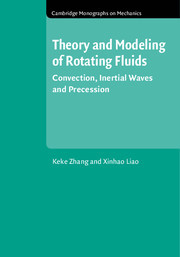Theory and Modeling of Rotating Fluids Convection, Inertial Waves and Precession Cambridge Monographs on Mechanics Series
Langue : Anglais
Auteurs : Zhang Keke, Liao Xinhao

The first systematic account of the theory and modelling of rotating fluids for researchers and students in geophysics, astrophysics and engineering in half a century.
A systematic account of the theory and modelling of rotating fluids that highlights the remarkable advances in the area and brings researchers and postgraduate students in atmospheres, oceanography, geophysics, astrophysics and engineering to the frontiers of research. Sufficient mathematical and numerical detail is provided in a variety of geometries such that the analysis and results can be readily reproduced, and many numerical tables are included to enable readers to compare or benchmark their own calculations. Traditionally, there are two disjointed topics in rotating fluids: convective fluid motion driven by buoyancy, discussed by Chandrasekhar (1961), and inertial waves and precession-driven flow, described by Greenspan (1968). Now, for the first time in book form, a unified theory is presented for three topics - thermal convection, inertial waves and precession-driven flow - to demonstrate that these seemingly complicated, and previously disconnected, problems become mathematically simple in the framework of an asymptotic approach that incorporates the essential characteristics of rotating fluids.
Part I. Fundamentals of Rotating Fluids: 1. Basic concepts and equations for rotating fluids; Part II. Inertial Waves in Uniformly Rotating Systems: 2. Introduction; 3. Inertial modes in rotating narrow-gap annuli; 4. Inertial modes in rotating cylinders; 5. Inertial modes in rotating; 6. Inertial modes in rotating oblate spheroids; 7. A proof of completeness of inertial modes in rotating channels; 8. Indications of completeness of inertial modes in rotating spheres; Part III. Precession and Libration in Non-Uniformly Rotating Systems: 9. Introduction; 10. Fluid motion in precessing narrow-gap annuli; 11. Fluid motion in precessing circular cylinders; 12. Fluid motion in precessing spheres; 13. Fluid motion in longitudinally librating spheres; 14. Fluid motion in precessing oblate spheroids; 15. Fluid motion in latitudinally librating spheroids; Part IV. Convection in Uniformly Rotating Systems: 16. Introduction; 17. Convection in rotating narrow-gap annuli; 18. Convection in rotating cylinders; 19. Convection in rotating spheres or spherical shells; Appendix A; Appendix B; References; Index.
Keke Zhang, Professor of Geophysical and Astrophysical Fluid Dynamics at the University of Exeter, obtained his B.Sc. in 1982 from Nanjing University, China, his M.Sc. in 1985 and his Ph.D. in 1987 from the University of California, Los Angeles. He is a Fellow of both the American Geophysical Union and the Royal Astronomical Society. Professor Zhang has authored over 180 publications in peer-reviewed scientific journals.
Xinhao Liao, Professor of Celestial Dynamics at the Chinese Academy of Sciences, obtained his B.Sc. in 1983 and his Ph.D. in 1989 from Nanjing University, China.
Xinhao Liao, Professor of Celestial Dynamics at the Chinese Academy of Sciences, obtained his B.Sc. in 1983 and his Ph.D. in 1989 from Nanjing University, China.
Date de parution : 05-2017
Ouvrage de 540 p.
18.2x25.4 cm
Disponible chez l'éditeur (délai d'approvisionnement : 14 jours).
Prix indicatif 177,01 €
Ajouter au panier
© 2024 LAVOISIER S.A.S.



